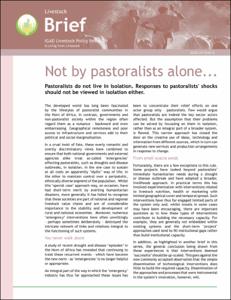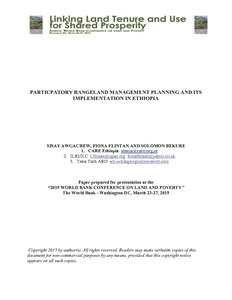On-farm characterization of the indigenons Small East African Shorthorn Zebu cattle (SEAZ) in the southeast rangelands of Kenya
Participatory disease searching using participatory epidemiology techniques in agropastoral and pastoral areas of Mbarara District, Uganda
Participatory investigation of relative incidence and impact on livelihoods of livestock diseases amongst the Turkana pastoralists in Kenya
Participatory modelling of pastoral and irrigated cropland ecosystems to identify linkages between environmental changes and local stakeholders’ health and well-being
Participatory rangeland management planning and its implementation in Ethiopia
The pastoral and agro-pastoral areas of Ethiopia cover around 65% of the country’s surface area. Rangeland resources are managed under collective common property arrangements, which are increasingly coming under pressure from both internal and external forces of change including alternative, but not necessarily ‘appropriate’, land uses.
Our land, our animals: Herding in Kenya's Kitengela rangelands
Nickson Parmisa, a resident of Kitengela just outside Nairobi in Kenya, talks about the challenges of livestock herding in the face of climate change.
Participatory analysis of vulnerability to drought in three agro-pastoral communities in the West African Sahel
Drought is one of the major climatic hazards impacting on the various sectors including crop and livestock in the West African Sahel. Pastoral and agro-pastoral communities in the region are regularly affected by drought, with vulnerability differing with gender, age, wealth status (access to cropland and livestock endowment), geographic location, social networks, and previous exposure to drought. Effective interventions require regular monitoring of vulnerability to drought, for which various quantitative and qualitative approaches exist.
Participatory definition of trait preference and pastorals’ indigenous knowledge on goat breeding strategy around Aysaita district, Ethiopia
Pastoralism 'alive and well' in Africa
Ian Scoones from the Institute of Development Studies and the Future Agricultures Consortium reflects on some key issues emerging from a recent conference on the future of pastoralism in Africa. His overwhelming conclusion: Pastoralism is "alive and well" in some parts of the continent. But there are downsides: constraints caused by pressures on land, as well as recurring conflicts. This leads to a division between those who are "really making it" and those who are "really struggling." This poses major policy issues at the two ends of these extremes.








